#time to update Wikipedia
Explore tagged Tumblr posts
Text
if anyone of the 7 people who like this band on here end up going to the live shows and end up in a good enough position to get a very good photo of all 3 band members you should totally release it into the public domain so it can be used on their Wikipedia page!
#half alive#half•alive#h•a#half alive content in the morning#i just noticed how old it is#time for an update !#Wikipedia#indie music#music
19 notes
·
View notes
Text
i like my parents SO much...
#i am having an outrageously good time calling them in the middle of the night to talk about weddings#now my mom is explaining that 'downriver' in michigan they consider muskrat to be kosher for lent#i mean. not kosher. whatever it is for catholics.#box opener#update: she's reading me the wikipedia page about the catholic priest who petitioned the pope for a special dispensation on the grounds#that muskrats live in the river and are easy to find.
9 notes
·
View notes
Text

Another Dohyo-Iri just dropped! Yokozuna Hoshoryu with sword bearer Ura and dew sweeper Kinbozan at Tokushoryu's retirement ceremony on February 1, 2025.
Hopefully he’ll be able to catch a break from all the dancing now, and can go back to training. ;)
#Hoshoryu#Ura#Kinbozan#dohyo iri#still giving me the tingles#also reading through his updated wikipedia page sent shiver after shiver down my body#now this time he had a bit of a ''no‚ to your other right'' situation ;)
4 notes
·
View notes
Text
These wnba Wikipedia editors are Fast
#like they had the Liz Dixon page updated#and bc I’m waiting very impatiently to know who the merc are signing#I’m checking the wnba transactions page multiple times a day#and Destanni Henderson signed with the dream today#and that has already been updated on her Wikipedia#compare that to women’s hockey where pages haven’t been updated since their college careers
3 notes
·
View notes
Text
from "Deep Ocean: The Lost World of The Pacific; part 1" narrated by David Attenborough
#guentherus katoi#marine biology#marine life#sea creatures#deep sea#first time i saw this i cried bc i thought it looked so beautiful#guentherus katoi is my favorite animal and i'm working on updating the guentherus article on wikipedia#i will find every piece of information on guentherus that i can
11 notes
·
View notes
Text
Tolerance Project extra a long time ago in a Galaxy far far away
The final cut
Part 1 The Farmboy The Princess and the Smuggler The Making of Star Wars and an out of this world Toyline
Introduction
Hello there and in honour of Star Wars Day may I present a new and revised edtion of a blog that looks at the Star Wars franchise well the first 6 episodes anyway
For ease of reading the blog has been split into 4 chapters each with new material part one includes new material on the Star wars comics better Youtube links for the videos and some of the material has been edited to make it a better read
This first chapter will cover the making of Star Wars and the amazing Toyline that followed it. Chapter 2 will cover the Empire Strikes Back including new material on the lost sequel Splinter of a Minds eye from 1978 Chapter 3 now covers Return of the jedi Part 4 will cover the Prequel trilogy and the links with the Tolerance Project.

Overview
Star Wars (retroactively titled Star Wars: Episode IV – A New Hope)* is a 1977 American epic space opera film written and directed by George Lucas, produced by Lucasfilm and distributed by 20th Century-Fox. It was the first film released in the Star Wars film series and fourth chronological chapter of the "Skywalker Saga". Set "a long time ago" in a fictional universe where the galaxy is ruled by the tyrannical Galactic Empire, the story focuses on a group of freedom fighters known as the Rebel Alliance, who aim to destroy the Empire's newest weapon, the Death Star. When Rebel leader Princess Leia is apprehended by the Empire, Luke Skywalker acquires stolen architectural plans of the Death Star and sets out to rescue her, while learning the ways of a metaphysical power known as "the Force" from Jedi Master Obi-Wan Kenobi. The cast includes Mark Hamill, Harrison Ford, Carrie Fisher, Peter Cushing, Alec Guinness, David Prowse, James Earl Jones, Anthony Daniels, Kenny Baker, and Peter Mayhew.

Lucas had the idea for a science-fiction film in the vein of Flash Gordon around the time he completed his first film, THX 1138 (1971) and began working on a treatment after the release of American Graffiti (1973).
To read about George Lucas’s orignal Star Wars plans as a 12 part film arc click here https://screenrant.com/star-wars-george-lucas-12-movie-plan/
After numerous rewrites, filming took place throughout 1975 and 1976 in locations including Tunisia and Elstree Studios in Hertfordshire, England.
The film suffered production difficulties; cast and crew involved believed the film would be a failure. Lucas formed the visual effects company Industrial Light & Magic to help create the film's special effects. It also went $3 million over budget due to delays.
To read about a lost version of the Star Wars film click here :https://movieweb.com/star-wars-original-version-lost/
Star Wars was released in a limited number of theatres in the United States on May 25, 1977 It was released in the UK on the 27 December 1977 6 months after US a bit strange as a large chunk of the film was made here it quickly became a huge hit
leading to it being expanded to a much wider release. The film opened to critical acclaim for its acting, direction, story, musical score, action sequences, sound, editing, screenplay, costume design, and production values, but particularly for its ground-breaking visual effects. It grossed $410 million worldwide during its initial run, surpassing Jaws (1975) to become the highest-grossing film until the release of E.T. the Extra-Terrestrial (1982); subsequent releases brought its total gross to $775 million. When adjusted for inflation, Star Wars is the second-highest-grossing film in North America (behind Gone with the Wind) and the fourth-highest-grossing film of all time. It received numerous awards at the Academy Awards, BAFTA Awards, and Saturn Awards, among others.
Star Wars in other Media
Books and comics
Star Wars From The Adventures Of Luke Skywalker Alan Dean Foster

Though initially credited to George Lucas, this Star Wars novelization was actually ghostwritten by sci-fi icon Alan Dean Foster, who wrote it based off the film’s shooting script and Xerox copies of artist Ralph McQuarrie’s pre-production paintings. Foster also spent a day in an Industrial Light And Magic screening room with Lucas and graphic designer Saul Bass, watching unedited, soundless footage of Tie Fighters zooming around and getting blown up.
From the Adventures of Luke Skywalker was published six months before the movie came out in May 1977, and it was panned by critics—but audiences loved it, and the book sold through its initial 500,000-print run by February, still three months before the film’s premiere. By the time the movie came out, another 3.5 million copies had been sold, making it one of the most successful novelizations of all time. (Foster was paid $7500 for the work—worth about $40,000 today
The novelization hits all the movie’s high points, but there are some fascinating differences (a lightsaber is described as a “gizmo” with “a number of jewel-like components built into both the handle and the disk,” for example) that give it a different type of feel from the film. It all adds more to the Star Wars universe, and some of details about certain planets, languages, history, and technology have since become canon for fans.
To go with the book that was in publication while George lucas was still making Star Wars the film was adapted into a a four part comic book series by Marvel Comics you can read about it by watching these 2 videos from Retro Marvel Man on Youtube
youtube
youtube
1979 Storybook and Tape
in 1979 Star Wars was turned into a 24 page book and tape by the Disney company you can listen to that version by clicking here
youtube
Radio

Just before Star Wars got a television Premiere in the UK it was adapted into a 13 part Radio series braodcast by NPR radio in the United states and BBC radio 1 in the UK.
It first aired in the US on March 2nd 1981 It was adapted by Brian Daley from the 1977 film, and directed by John Madden, with music by John Williams and sound design for Lucasfilm by Ben Burtt. The serial was recorded in 1981 at Westlake Recording Studios in West Hollywood, California.
Daley adapted the script partly using material from earlier drafts of Lucas's scripts, and restored several scenes cut from the final edit of the film, as well as adding original new scenes created specially for the audio version. The narrative of the first two episodes takes place entirely before the opening scene of the 1977 film, and expands the background to events leading up to the capture of the Tantive IV spacecraft above the planet Tatooine.
Episode 1, largely based on cut scenes from the original, explores the life of Luke Skywalker on Tatooine. During the story, Luke's skyhopper (a vehicle seen in the background in Luke's garage during the film) is damaged during a desert race; Luke sees the distant Star Destroyer battle in the sky; and he is reunited with his childhood friend, Biggs Darklighter. Episode 2, made up of material written entirely by Daley, provides backstory to Princess Leia's acquisition of the Death Star plans from agents of the Rebel Alliance on the planet Toprawa.
In scenes set on the planet Alderaan, Leia discusses the plans with her father, Prestor Organa, and determines to go in search of Obi-Wan Kenobi. Later episodes mostly follow the storyline of the film, but additional scenes expand the narrative. In one scene, Han Solo has a meeting with an agent of Jabba the Hutt called Heater; this dialogue is based on a scene in which Solo meets a humanoid Jabba in the docking bay, cut from the original film but later reinstated in the 1997 Special Edition in modified form. In another episode, Daley inserts a conversation in which Admiral Motti attempts to convince Grand Moff Tarkin to leverage the Death Star as a political tool.
Television
Star Wars Gets its first TV airing in the UK in 1982
I remember watching on its first British TV premeire when the ITV network showed on the 24th of October 1982 as a a 5 year old it left a rather big impression on me . with its massive space battles light saber fights and the souring music by John Williams here is a trailer for that very event. and the TV times magazine cover

Screenrant published an article on their website called 10 moves that redifined their Genres Star wars A New Hope was number 1 in their list so what made Star Wars so groundbreaking ?
Hollywood likely did not expect a new sci-fi movie with a space setting to change the genre yet again less than a decade after 2001: A Space Odyssey came out. Yet Star Wars became the biggest franchise of all time, with Star Wars: A New Hope being the second highest-grossing movie of all time when adjusted for inflation (via boxofficemojo.com). All blockbuster movies are held up to Star Wars as a comparison.
George Lucas' team notably used miniature models of futuristic ships to capture sequences of them flying through space while further developing the computer-generated effects of the time. Luke's storyline also helped popularize the "Hero's Journey" in cinema, which appears in The Matrix and Lord of the Rings (via IMDB). This demonstrates how genre-defining movies' influence may prove essential to yet another significant moment in cinematic history.
The Music of Star Wars Episode IV The New Hope

For me one of the strongest parts of Star Wars is the music by John Williams. Indeed Speaking as a personal fan of John Williams, I was first introduced to his work when I bought a double CD version of his music for the first star wars film for my birthday. I loved it but it took me a while to get the other soundtracks in the series. I didn’t get round to buying Empire and Return of the Jedi till the special edition Soundtrack releases in 1997.
I loved those as well and I have since bought all of the Star Wars Soundtracks that John Williams worked on.
Williams like John Barry before him had a magical talent for making the music come alive in my head to create scenes and adventures that I never saw on the cinema screen.
It was on the recommendation Spielberg, Lucas hired John Williams, who had worked with Spielberg on the film Jaws, for which he won an Academy Award. Lucas originally hired Williams to consult on music editing choices and to compose the source music for the music, telling Williams that he intended to use extant music.Lucas believed that the film would portray visually foreign worlds, but that a grand musical score would give the audience an emotional familiarity. Therefore, Lucas assembled his favourite orchestral pieces for the soundtrack, until Williams convinced him that an original score would be unique and more unified, having viewed Lucas's music choices as a temp track. However, a few of Williams's eventual pieces were influenced by the temp track: the "Main Title Theme" was inspired by the theme from the 1942 film Kings Row, scored by Erich Wolfgang Korngold;[135] and the track "Dune Sea of Tatooine" drew from the soundtrack of Bicycle Thieves, scored by Alessandro Cicognini.
Williams' score for Star Wars was recorded over eight sessions at Anvil Studios in Denham, England on March 5, 8–12, 15 and 16, 1977. The score was orchestrated by Williams, Herbert W. Spencer, Alexander Courage, Angela Morley, Arthur Morton and Albert Woodbury. Spencer orchestrated the scores for The Empire Strikes Back and Return of the Jedi. The score was recorded by engineer Eric Tomlinson and edited by Kenneth Wannberg, and the scoring sessions were produced by Star Wars director George Lucas and supervised by Lionel Newman, head of 20th Century Fox's music department.
The soundtrack album was released by 20th Century Records as a double-LP record in the United States in June 1977. The album's main title peaked at No. 10 on the Billboard Hot 100, with a disco version of the film's theme by Meco becoming a number one single hit in the United States in October 1977. You can learn more about the Meco version of the song by clicking here :
youtube
The soundtrack album itself became the best-selling symphonic album of all time;
To take a look at the original music manuscript for the Star Wars theme click here https://gizmodo.com/john-williams-star-wars-sheet-music-auction-darth-vader-1851265635
The Beginning Of the out of This World Toyline
The toys were made by Kenner in the US and released by Palitoy in the UK which imported the figures and packaged them in the UK on Palitoy branded cardbacks.
Between 1978 and 1985, Kenner produced and sold action figures based on the Star Wars franchise. From a line of over 100 unique toys, a total of more than 300 million units were sold during their original run.
The license for Star Wars action figures was offered in 1976 to the Mego Corporation, which was the leading company in action figures in the 1970s. Mego refused the offer and the license was subsequently picked up by Kenner.
Star Wars was the first film to successfully market toys based on the movie. In fact, they were so successful that George Lucas independently used the funds to finance the next two movie chapters, The Empire Strikes Back (1980) and Return of the Jedi (1983).
Although the original Star Wars film had been released in May 1977, Kenner was unprepared for the unprecedented response to the film and the high demand for toys, mainly due to George Lucas's unwillingness to provide character/vehicle designs for fear his creations would be plagiarized by movie/TV competitors. Unable to build sufficient stock in time for the lucrative Christmas market, they instead sold an "Early Bird Certificate Package" which included a certificate which could be mailed to Kenner and redeemed for four Star Wars action figures. The first four figures to be distributed were Luke Skywalker, Princess Leia, Chewbacca and R2-D2. The box also contains a diorama display stand, some stickers, and a Star Wars fan club membership card.
By the time the action figures were offered for direct sale in shops, the range had been augmented with a further eight figures—C-3PO, Darth Vader, Stormtrooper, Obi-Wan Kenobi, Han Solo, Jawa, Sand People, and Death Squad Commander—bringing the total number of figures in the initial release to twelve. These were supplemented later in 1978 with a number of vehicle and playset accessories, as well as the J.C. Penney exclusive Sonic controlled landspeeder and the Sears exclusive Cantina adventure playset which introduced four new figures.
You might also want to watch this documentary which covers the first 21 figures in the Star Wars toy range asking the question are they any good (95) Kenner's first 21 Star Wars figures | Are they any good?! - YouTube

The Original Star Wars Trilogy and Me
Toys
Like most children growing up in the 1980s Star wars was part of the landscape growing up Me and Matthew bought most of the toys and played Star wars at home..
I used to be Han Solo and Matthew my Brother would be Luke Skywalker my bed would be the Millennium Falcon and my Teddy Edward would be Chewbacca. To watch a documentary on the Star Wars toy range click here
youtube
The very first Star wars figure me and Matthew got as presents were a Darth Vader figure for me and Luke Skywalker Jedi knight for Matthew from our Nan.


From then on we would get figures as treats save up our pocket money or a get the figures or a spaceship/Vehicle for Christmas or a birthday present.
So it must have been about 1983 when we first got those figures I remember Luke Skywalker had a lightsaber that didnt fit in his hand very well and mum flatening Luke's blaster with her iron ha ha we sorted out the lightsaber problem when I bought the R2D2 figure that came with a lightsaber that seemed to fit his hand like a glove
Apprently the issue with Luke Skywalkers lightsaber has been fixed when the figure was re-issued for the Star Wars Black series

The first big Spaceship I remember getting as a birthday present was the Snow Speeder that Luke Skywalker flew during the Battle of Hoth in Empire a great flyer but very heavy to lift when your little the guns on the speeder would light up when you pressed a button.
youtube
Matthew got Luke’s X wing fighter the wings unfolded when you pressed a button on R2D2s head Toy Advert for the X wing and Tie fighter click here
youtube
The best Christmas present I ever got was the Millennium Falcon playset and Matthew was rather pleased when on the same day he got the Ework Village . Toy adverts for the Millennium Falcon playset click here
This video from Analog toys covers the top 10 Star wars vintage Vehicles Top 10 Vintage Star Wars Vehicles
youtube
advert for Ework village click here
youtube
We finish part one of this epic blog with Star Wars at the 50th Academy Awards in 1978 where it did rather well

Star Wars Oscars
The film garnered numerous accolades after its release. Star Wars won six competitive Academy Awards at the 50th Academy Awards: Best Art Direction, Best Costume Design, Best Film Editing, Best Original Score, Best Sound and Best Visual Effects. A Special Achievement for Sound Effects Editing went to sound designer Ben Burtt, and a Scientific and Engineering Award went to John Dykstra for the development of the Dykstraflex Camera (shared with Alvah J. Miller and Jerry Jeffress, who were both granted for the engineering of the Electronic Motion Control System).
To watch a collection of Star wars footage from the 1978 Oscars click here thanks to You Tube Star Wars at the 1978 Oscars
Pictures
Star Wars Poster from 1977
Star Wars from the Adventures of Luke Skywalker book cover from 1976
Star Wars Radio Poster from 1981
TV Times Magazine cover from October 1982
Early Bird toy promontion
Darth Vader action figure
Luke Skywalker Jedi Knight figure
R2D2 action figure with realible lightsaber
Star Wars Soundtrack album
Newspaper advert where Star Wars celebrates its Oscar success
Notes
Thank you to wikipedia for the background information on the making of Star Wars and its Toyline Thank you to Youtube for the Vairous adverts for the Star war toys also thank you to the vairous websites for their Star Wars articles featured in this first chapter including Movieweb, Screenrant, Gizmondo and Retro Marvel Man for his Youtube videos on the Star Wars comic adaptions
And the Star Wars Radio Youtube page for the 1979 storybook and tape version of the film
Next Week Tolerance Project extra a long time ago in a galaxy far far away part 2 a lost sequel an ice planet.
Further reading
The Movieweb website included Darth Vader at Number 3 in their article 10 Best Movie Character Introductions, Ranked you can read the full list by clicking here https://movieweb.com/movie-character-introductions/#james-bond-mdash-dr-no
This article list 20 of John Williams best film scores with both the scores for Star Wars and its sequel the Empire Strikes back both in the top 10 for the full list click here John Williams' best film scores of all time, ranked (avclub.com)
Another list of John Williams Iconic scores this time from the Collider.com website this time the soundtrack to Empire Strikes back gets a good mention but the soundtrack to Star Wars is not included for the full list click here :John Williams' Most Iconic Movie Soundtracks, Ranked (collider.com)
The Mary Sue film website also published a list of his 12 best film Scores you can read that by clicking here https://www.themarysue.com/best-john-williams-scores-ranked/
Collider.com reporting an AFI list (American film institute) of the top ten best Film soundtracks of all time Star Wars was number 1 in this list you can see the full list by clicking on this link 10 Best Movie Scores, According to the AFI (collider.com)
The 10 best movie trilogies of all time from the giant freaking Robot website the original Star Wars trilogy was number 2 in their list to read the article click here Best Movie Trilogies Of All-Time (giantfreakinrobot.com)
Screenrant published an article called Star Wars: The Best Track From Each John Williams Score Ranked you can read it by clicking here Star Wars: The Best Track From Each John Williams Score, Ranked (screenrant.com)
The Movieweb website published a list called the 18 greatest Scifi film Franchises of all time Star Wars was number 2 on their list you can read the full list by clicking here https://movieweb.com/best-sci-fi-film-franchises/#bill-and-ted
This article from the Screenrant websitle lists the 15 hidden details that can befound in the orignal Star Wars Trilogy https://screenrant.com/star-wars-original-trilogy-hidden-details/
Not everything is perfect in the Star Wars film series as this article from Screenrant points out click here to read https://screenrant.com/star-wars-empire-make-no-sense-problems/
Another interesting Star Wars article from Screenrant this article covers the 10 best Star wars mistakes that were left in the final cut this peice talks about the Star Wars universe as a whole so it covers all the films and the live action Tv series you can read it by clicking here https://screenrant.com/star-wars-10-best-mistakes-movies-live-action-tv-shows/#the-book-of-boba-fett-39-s-wooden-set-is-revealed
To learn more about Star Wars concept art read this article from the Screen Rant website about 15 star Wars concept drawings that reveal an alternate version of the films
The Star Wars Franchise topped Moviewebs list of 10 franchises with 4 or more films you can read the full article by clicking here https://movieweb.com/movie-franchises-with-four-sequels/#james-bond-1962-present
This article from the Screenrant website lists the 10 best moments from the original star Wars trilogy click here The 10 Best Scenes In The Star Wars Original Trilogy (screenrant.com)
An interesting article from the Collidar film website which covers the original Star Wars trilogy called 10 major flaws in the original Star Wars trilogy that are only noticeable now to read the article click here 10 Major Flaws in the Original Star Wars Trilogy That Are More Noticeable Now
Remember If you have read this blog and liked it please consider giving a donation to the Tolerance project by clicking on the above link thank you
#Kenner Toys#screenrant.com#movie web#george lucas#Star Wars#Oscar Winners#classic film#science fiction#wikipedia#Google images#Tolerance project Extra#Tolerance Project blog update#John Williams#luke skywalker#han solo#chewbacca#alan dean foster#tv times#1982#Youtube#Retro Marvel Man#Kenner toys#r2d2#Darth Vader#star wars comics#disney
3 notes
·
View notes
Text
@pianolexcat asks:

And well, this’ll surprise you: I had no idea what this car was! But weeding through the Ford range at the outer edges of my area of expertise ('50s North America), I found out it’s a 1958 Ford Custom. Here's the Wikipedia page about it, and here's the Scottish Wikipedia page I accidentally ended up on when trying to find it again!
Apparently, it wis a caur model name usied baith Ford in the Unitit States an Canadae frae the 1930s tae 1981 - but one fun fact I knew I had for y'all before even knowing that and which I am qualified to talk about as I think it was mentioned in my years professionally studying product design (though I can't promise I didn't bring it up myself) is why I know the year for certain!
See, the Custom name was used in many different ways, but the one that concerns us is what they stamped it on between 1957 and 1959.

I think we can all agree that's her, right? See the chrome curve at the edge of the roof and the gap between it and the rear windshield, the size and angle of the fins... that's her! But why could it not be a '57 or a '59 then? Easy:

Because in '57 the taillights, trunk lid, bumper and side trim were all completely different (and same for the front). And if that seems drastic...

...check it out for '59, where it didn't even retain the same glass.
And here's the kicker: before the fateful year of 1973 when the realization that petrol wasn't actually infinite destroyed the entire concept of America, this was normal. American cars of the '50s and '60s all had some aesthetic change pretty much every year, from a couple distinctive bits for a different look to a completely new body (which admittedly was easier back then with body on frame cars). Why? Because then the showroom cars were always fresh and new and thus prestigious, and used cars never were - you couldn't buy a car with as little as one year without it being an old model, forget something like five. Same reason you still see car models get little cosmetic updates partway into their lifespans, and why so many smartphones needlessly switch up their looks every generation! Of course, you don't see this everywhere because it needs to be a purchase expensive enough that people care and in a market wealthy enough that people can afford a needless upgrade over some flashy new feature or even just to get picky about what feels newer - so for instance old Eastern European cars are... not exactly known for a breakneck update frequency (see the cars below for what a one-year difference looks like in Poland. I'm just kidding, the yellow one is a quarter century newer).


In fact, I am pretty sure yearly refreshes are the origin of the predominance of referring to a car by year: to people who know enough about cars to know a model's generation, "1996 Miata" is usually just conveying "first generation Miata" with extra steps, so you'd only use it when referring to something that specifcally involves a subsection of that generation's years (e.g. "In my first gen Miata the battery is in the trunk" vs "In my 1996 Miata the oil pressure gauge is basically just a warning light in gauge form"). But in old American cars, every single year was at least somewhat different, so you'd always say " '58 Custom" to tell it apart from a '59 Custom and so on, which I think is where this tradition took hold. In fact, you see it most among Americans and discussion of American cars, with few examples more iconic than the '64 Impala being so famous and oft-mentioned in hip-hop tracks (most famously Eazy E's "cruising down the street in my '64" line) that as soon as '92 you could just say "rolling in my four" and people would know.
Of course, cars changing every year is a nightmare if you, say, bump your car and need a fender they only made for one year, which is why Volkswagen was very proud of rejecting that trend.

This will seem familiar to fans of the blog, and indeed is, apparently, the ad that inspired the VW Harlekin!
P.S. While normally this post would have gleefully derailed into explanations of model generations nomenclature and lowrider history, I am trying to shorten my posts. (Yes, dear blog newcomers, this is meant to be a shorter post.) Not because I don't want to write about those things - I in fact would LOVE to share the hilarious Subaru eye joke I found and if y'all don't know lowriders you NEED to let me make you one of today's lucky 10.000. It's just that putting all that inside a single post makes it a bitch to follow, a chore to read, and it means I take ages to answer your asks. So going forward, when I touch on potentially interesting topics to expand upon, I will note them and you can (as you always could) ask me to tell you about them through a post submission (or, if you can't, an ask)! Better organization, shorter posts and faster response times make a better future for everyone. Does it show I studied marketing?
Links in blue are posts of mine explaining the words in question - if you liked this post, you might like those!
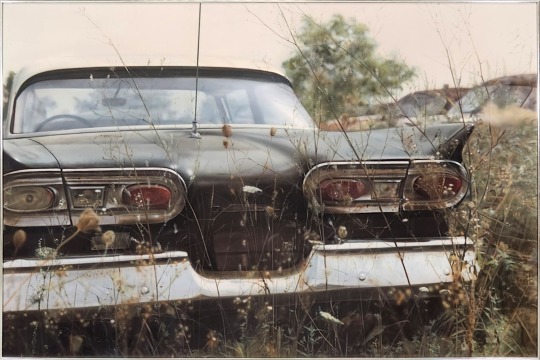
John Salt (British, 1937-2021), Black Ford in Field, 1972. Oil on canvas, 48 x 72 in.
#btw fun fact: Scottish Wikipedia was updated with the new layout which Italian Wikipedia still has not#in case you needed yet another proof of just how behind the times Italy consistently finds a way to be#years#ford custom#volkswagen beetle
100K notes
·
View notes
Text
one of my guys in the vendée globe went through some rough patches recently but he's all good now and i cannot convey how relieved i am. i have zero clue when i got this emotionally invested in his success but apparently i am
#i think it's the same as any other sports. why do we get invested i have no clue but we do#plus they're sailing solo around the world which is taking them upwards of 60 days#and that's a genuinely incredible feat. like winning the race is an amazing achievement but even just finishing it is so impressive#and i had no clue about this race until a month ago when i read a bunch of the contestants' wikipedia pages and got invested#they post videos and pictures regularly on the race's website and i got used to checking this guy jingkun xu's updates#i got so scared that he'd have to give up because one of his sails was stuck and he had to climb the 30m mast THREE times in as many days#he only has one hand to do it and he looked so (understandably) completely exhausted#but now he seems to be doing better and his last updates were good news. and it just makes me happy#yay! new interest unlocked#rambles
0 notes
Text
the wikipedia article for ttpd hasn't even updated yet omg (no i'm not doing it)
#taylor swift#the tortured poets department#ttpd#wikipedia#will probably update by the time you see this#original posts
0 notes
Text
Gävle Goat is Bock!
Welcome all straw goat and arson enthusiasts! Another year of Gävle Goat watching is upon us. Just a few things before the goat is officially up for the first Sunday of advent!
I will post the date on all of my goat updates, but it is still a good idea to turn timestamps on for your posts if you don’t already in case posts from old years start circulating.
I like to post my updates around midnight Swedish time, so keep in mind when that would be for your time zone if you are checking my blog for updates.
If you are looking for information about past goat activities I highly recommend the Gävle Goat Wikipedia page! I also have the tag Gavle goat lore where I have answered asks about the goat in past years.
I’m looking forward to another year of goat watching with all of you. You can find the livestream at the bottom of this post, updates will start on the first Sunday of advent (December 1st this year).
And as always best of luck to any potential arsonists out there!
youtube
4K notes
·
View notes
Photo

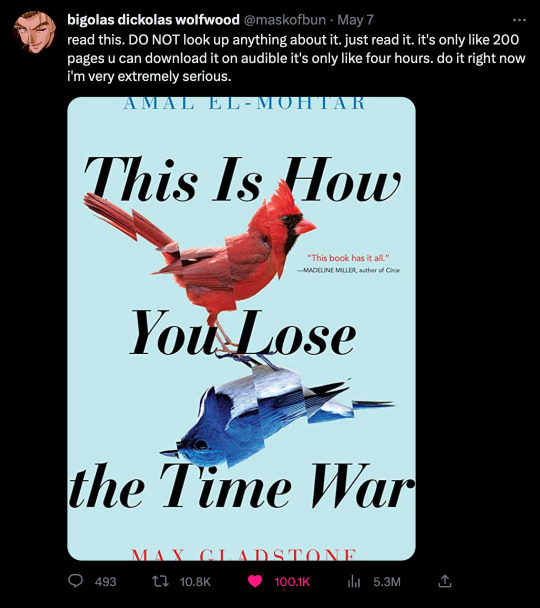
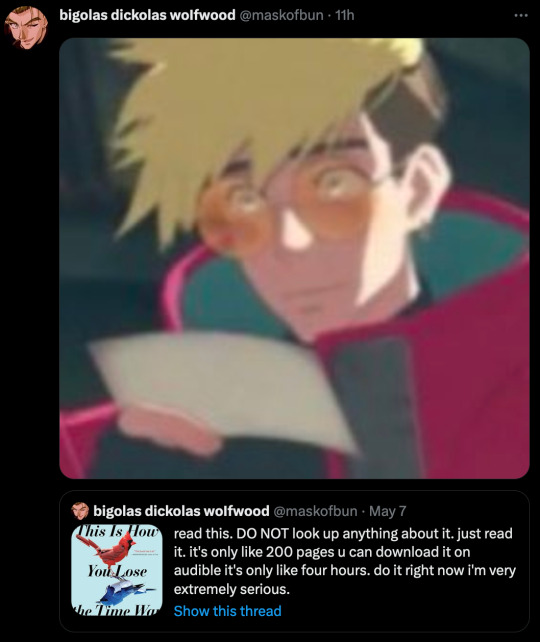

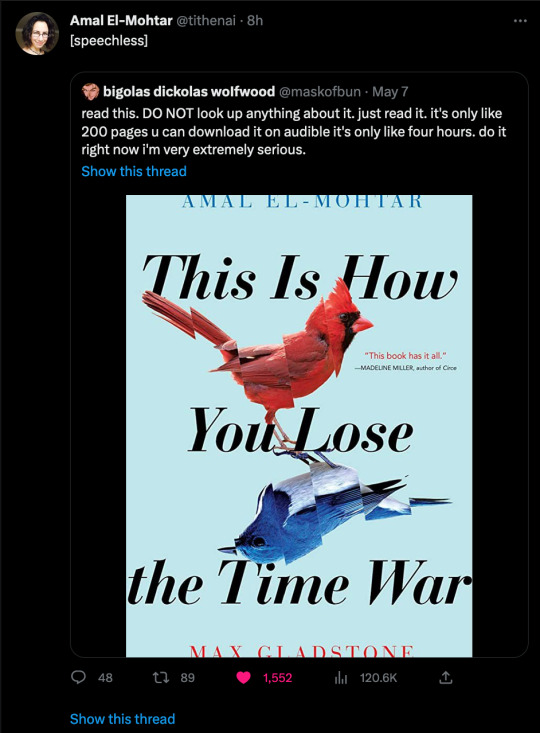
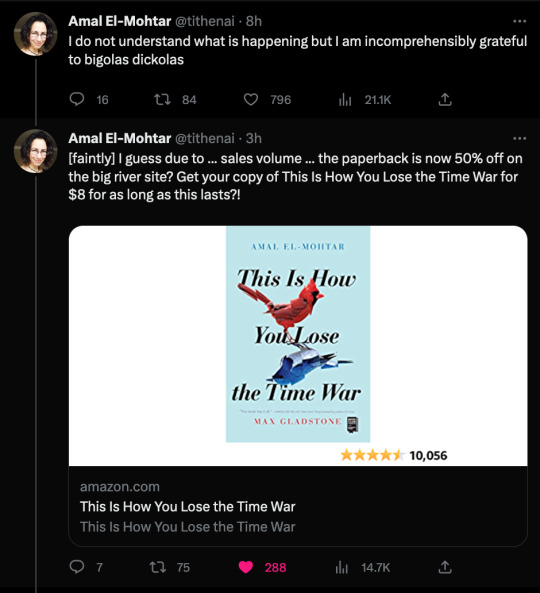
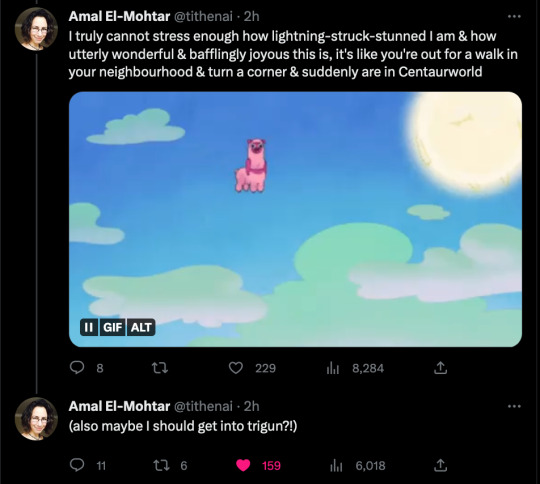
So, a funny thing happened on trigun twitter
(amazon link where its 50% off as of May 8th: https://www.amazon.com/This-How-You-Lose-Time/dp/1534430997/)
(more up to date version here because holy fuck did this escalate)
83K notes
·
View notes
Text
if you feel like you're always getting talked over, or if you feel like you're always accidentally interrupting people, you should consider looking into some of the linguistics research about conversation style and turn-taking. lingthusiasm podcast has a great episode called "how to rebalance a lopsided conversation" that goes over some of this research in a really accessible way; Deborah Tannen's book You just don't understand is an early book¹ that's aimed at general audiences on the same topic.
the thing is, when there's conflict in how a conversation flows, often what's going on is a mismatch in norms or expectations -- not that one person is necessarily acting "wrong" and the other person is "right." the mismatches in norms/expectations can and do align with existing power structures in society, but being more aware of them can really help you as an individual trying to navigate them.
you can train your brain for more linguistic awareness! start listening for pauses, intakes of breath, or back-channeling that's meant to support, not interrupt. try it out!
¹ I am linking to the wikipedia page for the book rather than a link to buy the book because it's kind of outdated and the criticism section on the wiki page is pretty reasonable. If you do read this book, be prepared for uhhhh period-typical gender essentialism that, to my knowledge, Tannen has not particularly updated her views on in the intervening time. But it is an influential and important book, just read it skeptically imo
2K notes
·
View notes
Text
I watched the live with the CEO, here is the tl;dr
The good news:
Chronological dash is here to stay! Whether you have to toggle it weekly or new users default to “For you” was not elaborated on but at least that’s confirmed.
Custom themes are here to stay! Once again, may be buried for all I know but, for sure will remain an option.
Search updates are in the works!!!!
The neutral news:
Tumblr is seriously in the red financially and needs more support, Ad-free for example is not widely used
They would not comment on the suggestion to bring back NSFW behind a paywall (which we all know would get them a boatload of money)
They’re possibly going to add a donation system like Ao3 and Wikipedia.
They would “rather not” sell data to make up the costs
Most of staff are pre-2010 tumblr users including the CEO who joined in 2007, so they do actually use the site and have for a long time
The bad news:
Condensed reblogs/removing duplicate reblogs is going forward. The reason cited was to meet “certain expectations” of users coming from other social media, which isn’t good.
Disability features (specifically turning off flashing ads for epileptics) was met with a request to purchase Ad-free @zingring clarified that they are looking into it but suggested Ad-free as more of a stopgap until something is put in place
Overall it was more chill than I expected, @photomatt and @zingring seem to be far more in tune with the userbase than u/spez.
36K notes
·
View notes
Text
My dear girl, there are some things that just aren't done, such as drinking Dom Perignon '53 above the temperature of 38 degrees Fahrenheit. That's just as bad as listening to The Beatles without earmuffs!” A blog inspired by the music world of James Bond Part 5 The film is great but the title is well
Introduction
Hello there and welcome to the final chapter of this extended series of blogs looking at the musical tastes of James Bond over the last 60 years .This chapter covers those tricky titles from the Ian Fleming James Bond stories that the script writers producers and song writers had a real struggle with. Two of those tricky titles Thunderball and the Spy who loved me have been dealt with in prevous chapters of the blog.
This Chapter of the blog deals with On her Majesty’s Secret service and Octopussy.


Casting The New James Bond
In 1967, after five films, Sean Connery resigned from the role of James Bond and was not on speaking terms with Albert Broccoli during the filming of You Only Live Twice.[27] Over 400 actors, including many of the most famous performers in the Commonwealth, were considered for the role of James Bond.[17]
The confirmed front runners were Englishman John Richardson, Dutchman Hans De Vries, Australian Robert Campbell, Scotsman Anthony Rogers, Greek Giorgos Fountas[28] and Australian George Lazenby.[14] Broccoli also met with Terence Stamp about playing the part.[29] Broccoli was interested in rising star Oliver Reed but decided his public image was already too distinct.
Future Bond star Timothy Dalton was asked to audition after his appearance in The Lion in Winter but considered himself too young, as he was 25 years old and did not want to succeed Connery as Bond. In an interview in 1987 when he was playing Bond in The Living Daylights, Dalton said "I was 24-25 then, I had a good career then as a young man in films The Lion in Winter and Mr Broccoli kindly asked me if I was interested, I think I'm just too young for this role. I think Bond should be between 35 and 40, and as a 25-26 year old and I wouldn't have been right".[17]
Broccoli and Hunt eventually chose Lazenby after seeing him in a Fry's Chocolate Cream advertisement.[18] Lazenby dressed the part by sporting several sartorial Bond elements such as a Rolex Submariner wristwatch and a Savile Row suit (ordered for, but uncollected by, Connery), and going to Connery's barber at the Dorchester Hotel.[19] Broccoli noticed Lazenby as a Bond-type man based on his physique and character elements, and offered him an audition. The position was consolidated when Lazenby accidentally punched a professional wrestler, who was acting as stunt coordinator, in the face, impressing Broccoli with his ability to display aggression.[14
The film website Screenrant recently published an article called How all 6 James Bond actors compare to the Ian Fleming Iconic Book spy they said this about George Lazenby.
Lazenby only lasted one movie in the role of Bond, but he couldn’t have had a better shot at the part. The tragic On Her Majesty’s Secret Service wouldn’t have worked without anyone else in the role, and journalist Ben McIntyre argued that the actor came closest to embodying Fleming’s take on Bond in his 2008 book For Your Eyes Only. It’s easy to see where McIntyre’s argument comes from, as Lazenby’s Bond took himself more seriously than Connery's did, much like Fleming’s version of the spy. Outside an infamous fourth-wall-breaking opening gag, his storyline was also more grounded, which allowed Lazenby to embody Bond’s troubled side.
Casting the leading lady
For Tracy Draco, the producers wanted an established actress opposite neophyte Lazenby.[30] Brigitte Bardot was invited, but after she signed to appear in Shalako opposite Sean Connery, the deal fell through,[16] and Diana Rigg—who had already been the popular heroine Emma Peel in The Avengers—was cast instead.[8] Rigg said one of the reasons for accepting the role was that she always wanted to be in an epic film.[18]
The Iconic Villian in her Majesty’s secret Service
On her Majesty’s sees the return of Ernst Stavro Blofeild this time by Telly Savalas he was played Donald Pleasence in you only live twice and would be played by Charles Grey in the following film Diamonds are Forever.
Recently Screenrantly published an article on their website titled Every James Bonds Iconic Villian Ranked and for George Lazenby they chose Blofeild lets face it they couldn’t choose amybody else.
George Lazenby only ever starred in one Bond movie, so he only ever faced one Bond villain, and that movie was sandwiched into the middle of Sean Connery’s arc, so he had to share his villain with Connery. But that villain happened to be Bond’s ultimate big bad, Ernst Stavro Blofeld. Connery faced other unforgettable villains like Dr. No and Auric Goldfinger, but Blofeld was their boss. Blofeld’s portrayal in the Bond movies – particularly in You Only Live Twice – has influenced how supervillains are depicted on-screen for decades. Blofeld is the quintessential Bond villain: a diabolical criminal mastermind who’s always one step ahead of 007.
A bunch of different actors have put their own stamp on the role of Blofeld over the years. Telly Savalas played the character opposite Lazenby in On Her Majesty’s Secret Service and Charles Gray played the part opposite a returning Connery in Diamonds Are Forever. But the most iconic take on the character (by far) is Donald Pleasence’s chilling performance alongside Connery in You Only Live Twice. The glint in Pleasence’s scarred eye is both mesmerizing and unsettling; he’s a captivating presence whenever he appears on-screen. Every James Bond movie villain since Pleasence’s Blofeld has been competing for the silver medal.
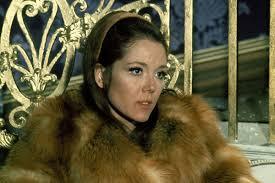
OHMSS A unique James Bond film
Taking over from Somebody in the lead role is difficult enough but when you take over the lead role from somebody as well known as Sean Connery in the most successful film franchise that is James Bond that task is even harder still
Considering it was it was also George Lazenby’s first lead role in a major film I thought George Lazenby’s take on James Bond in his only film was excellent On Her Majesty’s secret service is a unique film in my view in that its more of a charector piece than your usual James Bond spy story indeed more than in any other Bond film the gadgets take a backseat to the story for once and its more about the love story between James Bond and Tracey Draco than anything else
This is highlighted by the fact as well that the What Culture website picked the relationship between the too as their moment of the whole film.
On Her Majesty's Secret Service, despite George Lazenby's terrible performance as Bond, is one of the most elite installments of the series. It does many things incredibly well, but it's Bond's relationship with Tracy di Vicenzo (Diana Rigg) that really makes the film linger in one's mind.
It seems clear the film put a huge amount of effort into this part of the story - in fact, at one point, the film basically stops in order to show a very nice romantic montage of the pair set to Louis Armstrong's "We Have All the Time in the World" - and while it made for a very different film compared to its predecessors, it sure as hell paid off.
OHMSS offers up a genuinely moving, chemistry-filled romance that pulls viewers right in and is so good that not even Lazenby can ruin it. Besides, any deficiencies in his performance are counter-balanced by Diana Rigg's wonderful turn as Tracy.
In the end, the film concludes with Tracy's murder and this scene is still absolutely devastating all these years later. With this tragic ending, OHMSS basically does something similar to what No Time to Die did decades later, but it did it far better.
Screenrant published an article called Each Bond actors defining scene 6 moments that defined James Bond for George Lazenby they Chose Tracy’s death scene
George Lazenby only played Bond in one movie, but it just so happened to be one of the greatest Bond movies of all time. On Her Majesty’s Secret Service sees 007 falling in love for the first time and ends with him marrying Contessa Teresa di Vicenzo, better known as Tracy. Just as Bond seems to get a happy ending, and he heads off on his honeymoon with Tracy, his bride is gunned down by his enemies in a drive-by shooting. This is one of the saddest moments in Bond history, and Lazenby nails the raw emotions of a widowed newlywed in tears, cradling his dead wife.
Tracy was never mentioned enough in later movies, but nonetheless, in OHMSS itself this love story is easily its greatest asset, although the cinematography, action sequences and the franchise's best incarnation of Blofeld (played here by Telly Savalas) deserve mention too.
Tracy’s Death was also included in another Screenrant article titled 10 greatest James Bonds scenes ranked from worst to best landing at number 5 in their list they had this to say:
George Lazenby only appeared in one James Bond movie, and the actor had the hard job of replacing Sean Connery, the original 007 who, according to many viewers, is still the greatest to ever play the role. However, Connery’s Bond wouldn’t have worked in On Her Majesty’s Secret Service, as evidenced by the movie’s strongest scene. When 007 married his love interest, Tracy (Diana Rigg), only for her to be murdered by Blofeld (Telly Savalas), the unstoppable spy experienced his most crushing defeat in the franchise’s history. Poignant and brutal, this scene marked a turning point for Bond’s unflappable screen persona.
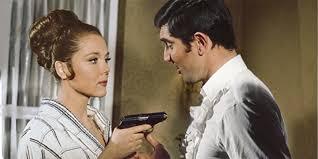
Besides the James Bond and Tracey love story the film sees bond trying to stop Blofield spreading Germ warfair by using innocent girls which he calls his angels of death indeed the Colider film highlighted these ladies as one of the highlights of the film in their article The 16 deadliest Women in the James Bond franchise arriving on the list at number 10.
The Angels of Death are 12 extremely attractive, wealthy, and sophisticated women who were selected by Irma Bunt (see below) from various countries to assist the Head of the crime organization SPECTRE, Ernst Stavro Blofeld (Telly Savalas), in contaminating, sterilizing, and eventually ransoming the world's food supply.

“TOTAL Infertility! In plants and animals. Not just disease in a few herds, Mr. Bond. Or the loss of a single crop. But the destruction of a whole strain. Forever! If my demands are not met, I shall proceed with the systematic extinction of whole species of cereals and livestock all over the world!” - Blofeld
Though a global threat, the ladies are actually regularly brainwashed and hypnotized, unbeknownst to them, thinking they are simply being treated for their specific food allergies in a luxurious Alpine facility.
Irma Bunt played by the German actress Ilse Steppat made an appearance in the same list making number 7 in the chart so a film that a film considered by some as a flop does have some highlights this is what they had to say :
Portrayed by the German actress Ilse Steppat, Irma Bunt is the stern middle-aged subordinate of Blofeld’s who runs the “allergy institute” in the Swiss Alps, “helping” the ladies with their allergies by day, and brainwashing them in their sleep. When Bond (the underrated George Lazenby) checks into the facility as a patient, she thoroughly has his luggage inspected, and informs him she enforces strict rules on all guests, such as not disclosing last names or room numbers. But then, his cover is blown, and after a relentless car chase, there is a big explosion, causing Bond to believe Bunt is dead. However, she later turns up at his own wedding, and attempts to shoot him with an M16, but she kills his new bride instead
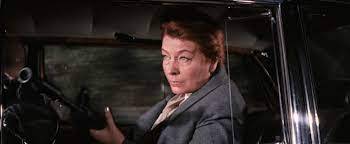
My thoughts on her Majestys secret service
Cinemagoers who came to see the film in 1969 most have had a big shock when they saw a more charector led story with a much more sensitive and emotional James Bond than they were used to but for me agaIn that's ok because sometimes a franchise even one like James Bond needs to take risk sometimes to stop it going stale and boring.
The film is will written and is well directored by Peter R Hunt It is the only Bond film to have been directed by him (with this serving as his directorial debut), he had served as a film editor and second unit director on previous films in the series.
OHMSS Brought to book
Peter R Hunt also had one of Ian Flemings best books to work with in Screenrants article which rated the 14 bond novels that Fleming wrote OHMSS came at number 4 in their chart they had this to say about the book
On Her Majesty's Secret Service followed the disaster that was The Spy Who Loved Me and, therefore, marked a return to form for both Fleming and the James Bond series. Though it contains much of the action and thrills of Fleming's other works, On Her Majesty's Secret Service offers a gentler and more tender approach than the previous entries. It all culminates in a gut-wrenching climax that once again proves that Fleming is far from a one-trick pony. An intriguing conspiracy and a worthy opponent in the form of Blofeld help make OHMSS a classic.
OHMSS features some of the best action scenes you will ever see in a Bond film the Stock car race and ski-ing sequences being particularly good that Yard Barker published an article called the 25 Greatest set peices in the Bond highlighting the films finale at Piz Gloria.
Again, listen to Soderbergh. This is an exquisitely shot and edited set-piece that kicks off with three helicopters assaulting Blofeld’s Piz Gloria stronghold, proceeds to crosscut between a tightly staged firefight and Tracy di Vicenzo (Diana Rigg) holding her own (and eventually killing) one of Blofeld’s thugs, then concludes with a (literally) breakneck bobsled chase. Director Peter Hunt’s aerial, exterior and interior photography matches perfectly; you’re always aware of where the characters are (including Bond as he belly-slides down an icy slope, machine gun blazing), and what they’re trying to achieve. This is how it’s done.
on this evidance then its such a shame that he never any more bond films after this.
If it was up to me Lazenby should have ignored his agents wishes and stayed in the role for one more film at least then perharps audiences would have got used to his more sensitive portrayal as James Bond
Mind you I think I am right in saying if George Lazenby had continued as James Bond we would not have had the Roger Moore era of James Bond that I loved as a child so perharps you can’t have everything you want
To watch a video review of OHMSS from the Oliver Harper YouTube channel click here https://www.youtube.com/watch?v=zfS0KRkQOo4
Music
John Barry who provided the soundtrack for the film which I conisder to be his best work for Bond provided an instrumential theme tune as he had done for the first two films Dr No and From Russia with love.
Barry felt it would be difficult to compose a theme song containing the title "On Her Majesty's Secret Service" unless it were written operatically, in the style of Gilbert and Sullivan. Leslie Bricusse had considered lyrics for the title song but director Peter R. Hunt allowed an instrumental title theme in the tradition of the first two Bond films. The theme is built around a lament bass, which establishes the story as a tragedy. Barry's composition was described as "one of the best title cuts, a wordless Moog-driven monster, suitable for skiing at breakneck speed or dancing with equal abandon.
The instrumental theme for ONHMSS is a John Barry classic . It would not grace the pop charts under its own steam. the dance band The Propellerheads would release a remix of theme working with David Arnold for his album James Bond remixed. the single reached number 7 in the UK charts you can listen to it by clicking here https://www.youtube.com/watch?v=zN8GcRGNWe4
Barry also composed the love song "We Have All the Time in the World", with lyrics by Burt Bacharach's regular lyricist Hal David, sung by Louis Armstrong. It is heard during the Bond–Tracy courtship montage, bridging Draco's birthday party in Portugal and Bond's burglary of the Gebrüder Gumbold law office in Bern, Switzerland.
The song doesn’t appear till 30 mins into the film gentle and reflective the song was the last studio recording by Louis Armstrong and features a beautiful and thrilling string arrangement that was modifed by Barry to play on Low strings as a jaunty theme for Bond in some of the films earlier sequences one of the most interesting and symbolic uses of music in the Bond film as 007 discusses Tracey with her father and Draco suggests that her daughter needs a man to dominate her !
Barry recalled Armstrong was very ill, but recorded the song in one take. Armstrong did, however, make some further recordings in 1970 and 1971. The song was re-released in 1994, achieving the number three position during a 13-week spell in the UK charts. When it was used for a Guinness infinity beer campaign.
The song was reused for a second Bond movie, when it was used as the soundtrack for the closing credits for the 2021 release No Time to Die.
To watch a trailer for on Her Majesty’s Secret sevice click here https://www.youtube.com/watch?v=dOLq5Rg9N-c&list=PL17vqAEJv6CUxmeZBk3JGDLBbcPEd4CDp&index=1
To watch a tribuite video for OHMSS click here https://www.youtube.com/watch?v=y35cTSFFeYU
Octopussy

Octopussy is a 1983 spy film and the thirteenth in the James Bond series produced by Eon Productions. It is the sixth to star Roger Moore as the MI6 agent James Bond. It was directed by John Glen and the screenplay was written by George MacDonald Fraser, Richard Maibaum and Michael G. Wilson.
The film's title is taken from a short story in Ian Fleming's 1966 short story collection Octopussy and The Living Daylights,
I like this film a lot again as with all the Bond films I enjoy it has a good mix of action and comedy and is well written and well directored by John Glenn ( his 2nd James Bond film after (for your eyes only)
His direction of the film was picked out of the What Culture website Best Bond moments article
Octopussy, with its stubborn insistence on prioritizing cringy comedy over thrills and a generally ill-conceived plot, is definitely one of the low points of the series (and one that totally ignored what made the previous film work) but it's not a total wash-out.
If there's one person who really comes out of the film with their dignity intact, it's John Glen, who directed five Bond movies, starting with For Your Eyes Only and finishing with Licence to Kill.
Glen is definitely one of the best directors the series ever had; he was already doing great work as an editor in the franchise, and once he stepped into the director's chair, he always directed with flair and precision, delivering many stunning visuals in the process.
Once again, just like with For Your Eyes Only, Glen does a smashing job and ensured that, despite how dated the film is on a writing level, it still looks absolutely terrific - especially during the picture's aerial action scenes.
The film also has Maud Adams this time returning as Octopussy She featured at number 9 in the 10 most deadliest women in the James Bond Franchise on the Movie web website who had this to say about Octopussy
Octopussy: [Bond sneaks into her room] Good evening. I wondered when you might arrive.
Bond: So, you are the mysterious Octopussy.
Octopussy: And you are James Bond, 007, licensed to kill. Am l to be your target for tonight?
Bond: Oh no, not necessarily. Depends how much you tell me about jewelry smuggling. And why one of our agents was killed in East Berlin.
Maud Adams plays Octopussy, a powerful smuggler of rare jewels, and the leader of an ancient cult of lone, fierce, and heavily trained acrobats, all of them women, and living on a secluded island in India. Her associate is an exiled Afghan prince, Kamal Khan, who also has members of the Cult of Octopus among his servants. Octopussy will eventually join forces with Bond (Roger Moore) against her ally
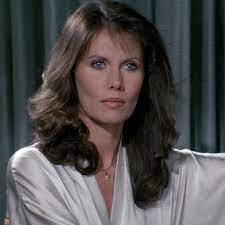
Music
Rather than use the word Octopussy in the title of the song the producers of the James Bond film did the most refreashing thing and decided not to mention it all instead we got a song called All Time High.
Once again John Barry provided the Soundtrack for the film theme "All Time High" with lyricist Tim Rice. "All Time High", sung by Rita Coolidge, is one of seven musical themes in the James Bond series whose song titles do not refer to the film's title. "All Time High" spent four weeks at number one on the United States' Adult Contemporary singles chart and reached number 36 on the Billboard Hot 100.[25]
To watch a video short about the making of Octopussy called 10 things you never new about Octopussy Click here https://www.youtube.com/watch?v=jhwpkASnFlM&t=32s
To watch a trailer for Octopussy click here https://www.youtube.com/watch?v=q1hLWZzgZvU
a lot of work has gone into this blog if you have read it and liked it please consider sending a donation to the Tolerance project by clicking on the above link https://gofund.me/5cf25de4
Notes
If your wondering where the title of this blog comes from it features in the 3rd James Bond film Goldfinger which is rightly seen by many as a classic Bond film and probably the best Bond film ever made. it was the first Bond film to make over a 100 million at the box office with a great mix of action comedy girls and gadgets and featured a great Goldfinger title song sung by Shirley Bassey the song itself made the top 30 in the UK charts
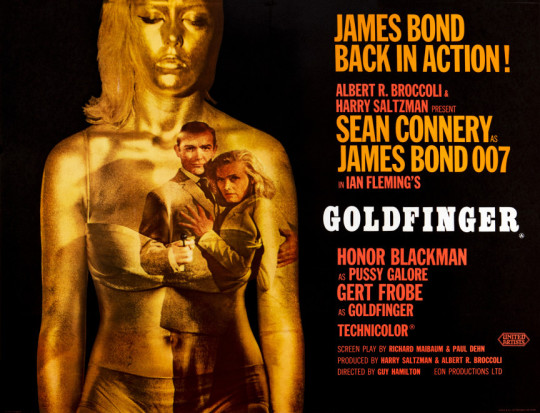
To watch a trailer for Goldfinger click here https://www.youtube.com/watch?v=MA65V-oLKa8&list=PL17vqAEJv6CUxmeZBk3JGDLBbcPEd4CDp&index=12
Thanks once again to Wikipedia for the background notes this time on the songs All time high and We have all the time in the world the Oliver Harper Youtube page for the OHMSS Retrospective review video Storm Chaser Z you tube channel for the viarous James bond videos and the Cinema Blend website for the series of articles called James Bond ranked
And Google Images for the viarous pictures of the viarous eras of James Bond
Pictures
1) Poster for OHMSS
2) Diana Rigg as Tracy
3) Diana Rigg as Tracey
4) Tracey and James Bond
5) The Angels of Death
6) Erima Bunt
7) Octpussy Poster
8) Octopussy herself
9) One of the many Posters for Goldfinger
#we have all the time in the world#louis armstrong#james bond#george lazenby#diana rigg#ohmss#octopussy#Erima Bunt#angels of death#John Barry#Roger Moore#goldfinger#wikipedia#The What Culture website#google images#Storm chaser Z#Oliver Harper Youtube channel#Tolerance project Blog update#for your eyes only#licence to kill#all time high#rita coolidge#Yard Barker website#screenrant.com
6 notes
·
View notes
Text
How lock-in hurts design

Berliners: Otherland has added a second date (Jan 28) for my book-talk after the first one sold out - book now!

If you've ever read about design, you've probably encountered the idea of "paving the desire path." A "desire path" is an erosion path created by people departing from the official walkway and taking their own route. The story goes that smart campus planners don't fight the desire paths laid down by students; they pave them, formalizing the route that their constituents have voted for with their feet.
Desire paths aren't always great (Wikipedia notes that "desire paths sometimes cut through sensitive habitats and exclusion zones, threatening wildlife and park security"), but in the context of design, a desire path is a way that users communicate with designers, creating a feedback loop between those two groups. The designers make a product, the users use it in ways that surprise the designer, and the designer integrates all that into a new revision of the product.
This method is widely heralded as a means of "co-innovating" between users and companies. Designers who practice the method are lauded for their humility, their willingness to learn from their users. Tech history is strewn with examples of successful paved desire-paths.
Take John Deere. While today the company is notorious for its war on its customers (via its opposition to right to repair), Deere was once a leader in co-innovation, dispatching roving field engineers to visit farms and learn how farmers had modified their tractors. The best of these modifications would then be worked into the next round of tractor designs, in a virtuous cycle:
https://securityledger.com/2019/03/opinion-my-grandfathers-john-deere-would-support-our-right-to-repair/
But this pattern is even more pronounced in the digital world, because it's much easier to update a digital service than it is to update all the tractors in the field, especially if that service is cloud-based, meaning you can modify the back-end everyone is instantly updated. The most celebrated example of this co-creation is Twitter, whose users created a host of its core features.
Retweets, for example, were a user creation. Users who saw something they liked on the service would type "RT" and paste the text and the link into a new tweet composition window. Same for quote-tweets: users copied the URL for a tweet and pasted it in below their own commentary. Twitter designers observed this user innovation and formalized it, turning it into part of Twitter's core feature-set.
Companies are obsessed with discovering digital desire paths. They pay fortunes for analytics software to produce maps of how their users interact with their services, run focus groups, even embed sneaky screen-recording software into their web-pages:
https://www.wired.com/story/the-dark-side-of-replay-sessions-that-record-your-every-move-online/
This relentless surveillance of users is pursued in the name of making things better for them: let us spy on you and we'll figure out where your pain-points and friction are coming from, and remove those. We all win!
But this impulse is a world apart from the humility and respect implied by co-innovation. The constant, nonconsensual observation of users has more to do with controlling users than learning from them.
That is, after all, the ethos of modern technology: the more control a company can exert over its users ,the more value it can transfer from those users to its shareholders. That's the key to enshittification, the ubiquitous platform decay that has degraded virtually all the technology we use, making it worse every day:
https://pluralistic.net/2023/02/19/twiddler/
When you are seeking to control users, the desire paths they create are all too frequently a means to wrestling control back from you. Take advertising: every time a service makes its ads more obnoxious and invasive, it creates an incentive for its users to search for "how do I install an ad-blocker":
https://www.eff.org/deeplinks/2019/07/adblocking-how-about-nah
More than half of all web-users have installed ad-blockers. It's the largest consumer boycott in human history:
https://doc.searls.com/2023/11/11/how-is-the-worlds-biggest-boycott-doing/
But zero app users have installed ad-blockers, because reverse-engineering an app requires that you bypass its encryption, triggering liability under Section 1201 of the Digital Millennium Copyright Act. This law provides for a $500,000 fine and a 5-year prison sentence for "circumvention" of access controls:
https://pluralistic.net/2024/01/12/youre-holding-it-wrong/#if-dishwashers-were-iphones
Beyond that, modifying an app creates liability under copyright, trademark, patent, trade secrets, noncompete, nondisclosure and so on. It's what Jay Freeman calls "felony contempt of business model":
https://locusmag.com/2020/09/cory-doctorow-ip/
This is why services are so horny to drive you to install their app rather using their websites: they are trying to get you to do something that, given your druthers, you would prefer not to do. They want to force you to exit through the gift shop, you want to carve a desire path straight to the parking lot. Apps let them mobilize the law to literally criminalize those desire paths.
An app is just a web-page wrapped in enough IP to make it a felony to block ads in it (or do anything else that wrestles value back from a company). Apps are web-pages where everything not forbidden is mandatory.
Seen in this light, an app is a way to wage war on desire paths, to abandon the cooperative model for co-innovation in favor of the adversarial model of user control and extraction.
Corporate apologists like to claim that the proliferation of apps proves that users like them. Neoliberal economists love the idea that business as usual represents a "revealed preference." This is an intellectually unserious tautology: "you do this, so you must like it":
https://boingboing.net/2024/01/22/hp-ceo-says-customers-are-a-bad-investment-unless-they-can-be-made-to-buy-companys-drm-ink-cartridges.html
Calling an action where no alternatives are permissible a "preference" or a "choice" is a cheap trick – especially when considered against the "preferences" that reveal themselves when a real choice is possible. Take commercial surveillance: when Apple gave Ios users a choice about being spied on – a one-click opt of of app-based surveillance – 96% of users choice no spying:
https://arstechnica.com/gadgets/2021/05/96-of-us-users-opt-out-of-app-tracking-in-ios-14-5-analytics-find/
But then Apple started spying on those very same users that had opted out of spying by Facebook and other Apple competitors:
https://pluralistic.net/2022/11/14/luxury-surveillance/#liar-liar
Neoclassical economists aren't just obsessed with revealed preferences – they also love to bandy about the idea of "moral hazard": economic arrangements that tempt people to be dishonest. This is typically applied to the public ("consumers" in the contemptuous parlance of econospeak). But apps are pure moral hazard – for corporations. The ability to prohibit desire paths – and literally imprison rivals who help your users thwart those prohibitions – is too tempting for companies to resist.
The fact that the majority of web users block ads reveals a strong preference for not being spied on ("users just want relevant ads" is such an obvious lie that doesn't merit any serious discussion):
https://www.iccl.ie/news/82-of-the-irish-public-wants-big-techs-toxic-algorithms-switched-off/
Giant companies attained their scale by learning from their users, not by thwarting them. The person using technology always knows something about what they need to do and how they want to do it that the designers can never anticipate. This is especially true of people who are unlike those designers – people who live on the other side of the world, or the other side of the economic divide, or whose bodies don't work the way that the designers' bodies do:
https://pluralistic.net/2022/10/20/benevolent-dictators/#felony-contempt-of-business-model
Apps – and other technologies that are locked down so their users can be locked in – are the height of technological arrogance. They embody a belief that users are to be told, not heard. If a user wants to do something that the designer didn't anticipate, that's the user's fault:
https://www.wired.com/2010/06/iphone-4-holding-it-wrong/
Corporate enthusiasm for prohibiting you from reconfiguring the tools you use to suit your needs is a declaration of the end of history. "Sure," John Deere execs say, "we once learned from farmers by observing how they modified their tractors. But today's farmers are so much stupider and we are so much smarter that we have nothing to learn from them anymore."
Spying on your users to control them is a poor substitute asking your users their permission to learn from them. Without technological self-determination, preferences can't be revealed. Without the right to seize the means of computation, the desire paths never emerge, leaving designers in the dark about what users really want.
Our policymakers swear loyalty to "innovation" but when corporations ask for the right to decide who can innovate and how, they fall all over themselves to create laws that let companies punish users for the crime of contempt of business-model.
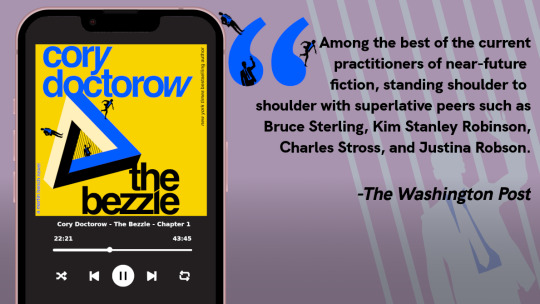
I'm Kickstarting the audiobook for The Bezzle, the sequel to Red Team Blues, narrated by @wilwheaton! You can pre-order the audiobook and ebook, DRM free, as well as the hardcover, signed or unsigned. There's also bundles with Red Team Blues in ebook, audio or paperback.

If you'd like an essay-formatted version of this post to read or share, here's a link to it on pluralistic.net, my surveillance-free, ad-free, tracker-free blog:
https://pluralistic.net/2024/01/24/everything-not-mandatory/#is-prohibited

Image: Belem (modified) https://commons.wikimedia.org/wiki/File:Desire_path_%2819811581366%29.jpg
CC BY 2.0 https://creativecommons.org/licenses/by/2.0/deed.en
#pluralistic#desire paths#design#drm#everything not mandatory is prohibited#apps#ip#innovation#user innovation#technological self-determination#john deere#twitter#felony contempt of business model
3K notes
·
View notes
Note
currently your wikipedia article uses excusively she/her pronouns despite your bio saying that you use it/its (and the article itself saying you use it/she will a strong preference for it) would you like that updated?
no, there is a big massive note on the article saying to specifically not do this and it has been discussed with me numerous times, in fact the reason the article on me is edit protected is because people kept trying to edit the pronouns despite being explicitly told (sometimes by me) not to do so
1K notes
·
View notes